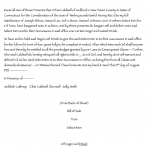When we New Englanders write and teach about slavery in the period from the Civil War to the present, we often forget that slavery didn’t exist only in the South. President Lincoln in his Second Inaugural Address urged Americans to “judge not, that we be not judged,” urging forgiveness of our Southern brethren. But Northern slavery, and Northern complicity with Southern slavery, were not rare occurrences. In Guilford, our cultural ancestors benefited from the labor of slaves, and we are lucky to have sources available to open our eyes to the existence of slavery in New England and in early Guilford.
Some of the best recent research into slavery in New England was done by writers from the Hartford Courant a decade ago. “Complicity; How Connecticut Chained Itself to Slavery” (Sept 29, 2002) describes in detail who owned slaves in Connecticut and how both individuals and corporations benefited and profited by the ownership and support of slavery. Robert H. Romer, in his book Slavery in the Connecticut Valley of Massachusetts (2009), while focusing on Deerfield, Massachusetts in the 18th century, shows us who was more likely to own slaves in a New England town or village, and also gives us hints on where to look for proof of slavery in the remaining historical artifacts and documents.
We have been given hints about slavery in Guilford. In North Guilford at the Meeting House Hill Cemetery, we can find the gravestone of the slave Shem. On the Green, we can see the names of African American soldiers who fought and died to preserve the Union and free the slaves in the South. In the Edith B. Nettleton Local History Room at the Guilford Free Library, we can find emancipation documents for Guilford slaves. I am just starting to analyze the census data from the 1790s and early 1800s to help me understand more about these slaves and the community they were a part of.
The question that has stuck in my mind since I first realized that there was, here in Guilford, a measurable slave and free Black population is, “What has happened to that population of slaves and free Blacks and did they find success in their transition from servitude to physical and economic freedom?” As I continue to conduct research, and to hopefully share the information in a more formal way, I wanted to share some of the raw data.
In the 1790 Federal Census, there were about 40 slaves listed in Guilford and about twenty free Blacks. All of the slaves and most of the free Blacks were unnamed. In 1790, the only names listed were the heads of households and the majority of free Blacks and all of the slaves were included within the households of white citizens.
Historically, Connecticut began to prepare to free its slaves by a process of gradual emancipation. They first enacted a law specifiying that a person born to a slave after 1792 was to remain a slave only until his or her 25th birthday. This law was later amended so that the individual would be free after their 21st birthday. Because this law affected only the children of slaves, it allowed slavery to continue into the 1840s.
Interestingly enough, the idea that slavery should be abolished seemed to be enough to change the attitudes of many in Guilford. By the 1800 Federal Census, the number of slaves was cut in half to 20, while the number of free Blacks doubled, leaving the overall number of Blacks in Guilford about the same as a decade earlier.
Another interesting thread to follow is that of Pvt. Henry Wright, who is listed on the Guilford Civil War Monument as fighting and dying while serving with the 54th Massachusetts Regiment, the famed Black regiment. Through census data, I have been able to connect Pvt. Wright to a free Black named Prince, who is one of the few free Blacks listed as “head of household” in the census. If I could find Prince’s background and if he had been a slave, there might be an interesting generational story to tell.
I hope that in journals, letters, family papers, probate records, account ledgers, and colonial records, information will be found to develop a clear picture of slavery in Guilford. I plan to share with my readers via this column the results of my research of this period in our local history.
Dennis Culliton
January 2013




